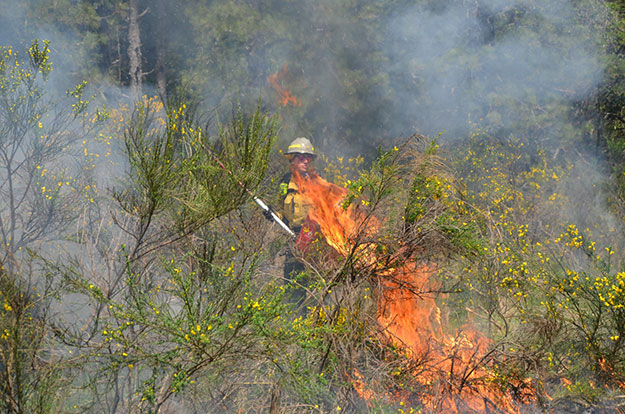There are a few things you can generally count on during a summer at Joint Base Lewis-McChord (JBLM) -- hot weather and smoke. Over the past few years, most of that smoke can be attributed to wildfires raging from California to Canada. That's why JBLM does prescribed burns -- a necessary preventive step that keeps JBLM and the surrounding community safe by eliminating the fuel that can feed potential wildfires.
The JBLM Directorate of Public Works Environmental Division works with the JBLM Fire and Emergency Services and other agencies to conduct prescribed burns for wildfire prevention, military land enhancement and ecological restoration.
 "The difference between prescribed fires and wildfires, is with prescribed fires, you have more control over your fire intensity," said Nick Miller, JBLM wildland fire program manager. "It's also easy to keep the fire specifically where you want it, whereas with wildfires, it's out there on its own and we're trying to catch up with it. That's why prescribed fires are so much safer."
"The difference between prescribed fires and wildfires, is with prescribed fires, you have more control over your fire intensity," said Nick Miller, JBLM wildland fire program manager. "It's also easy to keep the fire specifically where you want it, whereas with wildfires, it's out there on its own and we're trying to catch up with it. That's why prescribed fires are so much safer."
While many people think it's a new practice, prescribed burns have been going on for hundreds of years.
Native Americans are believed to have passed the practice on to the first European settlers and the prescribed burns largely continued until the early 20th century. Due to misinformation about the effects of prescribed burns, the general consensus became that all fires were bad fires, and the practice was largely halted throughout the United States around 1913.
But instead of protecting the public and the forests, fire suppression led to the accumulation of fuel loads, or the amount of flammable material, such as underbrush in an area, which in turn led to devastating wildfires.
This led to the U.S. Forest Service repealing the Forest Fires Emergency Act in 1978, which required all fires to be extinguished as quickly as possible.
Prescribed burns are also used by JBLM for military land enhancement. Training exercises conducted on base can ignite wildfires, but the use of prescribed burns decreases the chance of these fires burning out of control.
"Prescribed burns reduce fuel loads on the landscape which minimizes the intensity at which a fire will burn," said Miller. "A fire burning in an area of reduced fuels typically moves slower and is more easily extinguished. For these reasons, when a fire is ignited near servicemembers, they have more time to move to a safer place while awaiting fire response personnel. There is also less chance of a fire being ignited by a training exercise in an area recently burned by a prescribed fire."
The ecosystem on JBLM also depends on the fire to survive.
"We have a lot of endangered species on JBLM, and a lot of them require native prairie habitats to thrive," said Emily Richardson, a JBLM biologist. "These native prairie habitats are fire-adapted ecosystems which mean they require fire to produce the plants that animals here need to survive. If fire didn't burn in this area, things like Scotch broom, an invasive species, would take over."
The burn season usually starts in late spring and continues throughout the summer on base. To find out when prescribed burns will take place, subscribe to the Sustainable JBLM Facebook page.
For more information about prescribed fires on JBLM, visit: https://home.army.mil/lewis-mcchord/index.php/my-Joint-Base-Lewis-Mcchord/all-services/public_works-environmental_division/wildland-fire.





Read Comments